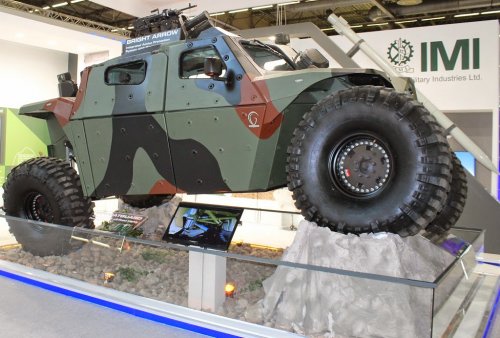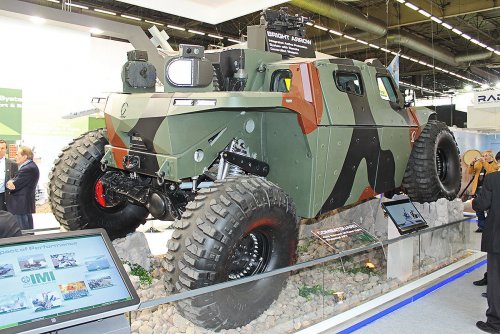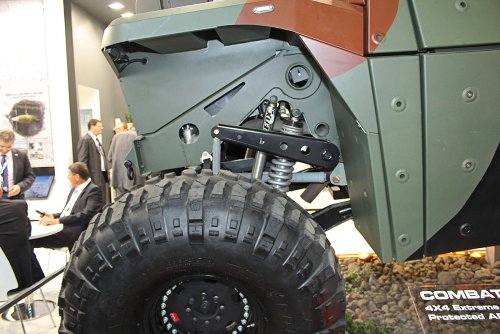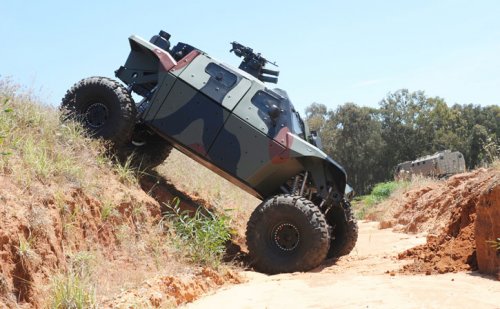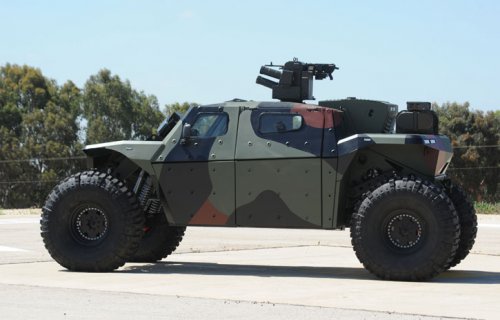TEL AVIV — State-owned Israel Military Industries (IMI) has concluded initial prototype testing of an armored, actively protected, wheeled vehicle designed to defend maneuvering ground troops against anti-tank missiles and rocket-propelled grenades.
The 6-ton, four-wheel-drive CombatGuard is built to deploy up to six infantrymen while Bright Arrow, the active protection system (APS) mounted on top of the vehicle, independently searches and responds to incoming threats.
IMI plans to unveil the Bright Arrow-equipped CombatGuard vehicle this week at the international Eurosatory exhibition in Paris, executives here say.
“As far as we know, it’s unique in the world because it was designed from the very beginning for optimum operational performance in harsh, high-threat conditions,” said Alon Fridman, manager of IMI’s Infantry and Special Forces Directorate.
“It’s built to rapidly deploy protected forces into and across theaters … and to transition seamlessly from routine border control and stability operations to high-intensity warfare,” said Fridman, a brigadier general in the Israel Defense Forces (IDF) reserves.
In a June 2 interview, Fridman said the APS-equipped CombatGuard embodied central, hard-learned lessons from Israel’s 2006 Lebanon War, where he served on theater command staff of the IDF’s Northern Command.
“It’s a very flexible vehicle that allows forces to come in from different directions despite the threat and without having to be concerned about terrain obstacles.”
Israeli forces in the 34-day war against Lebanese-based Hezbollah suffered significant setbacks due to poor maneuvering capabilities in the face of anti-tank missiles and other threats.
Bright Arrow, he said, is now in final phases of developmental testing. It combines hard-kill and soft-kill active protection with a stabilized, automatic 7.62mm machine gun all integrated in a single pedestal and mounted atop the armored off-road vehicle.
Based on the firm’s Iron Fist APS, Bright Arrow uses electro-optical and radar sensors to search for threats. Once threats are classified and designated, the system’s multi-layered countermeasures determines whether to neutralize threats through electro-optical jamming, deflect them by smoke or destroy them by firing hard-kill projectiles.
“It will give you the ability not only to protect your forces, but to attack the enemy that fired at you,” Fridman said.
According to IMI material, CombatGuard can carry a 1.2-ton payload at maximum road speeds of 150 kilometers per hour. Off-road performance provided by customized 54-inch wheels and its 300-horsepower diesel engine allow it to ford water up to 1.5 meters deep and climb vertical obstacles up to 80 centimeters high while driving forward or reverse.
Fridman said the modular design allows for vehicles customized for multiple missions, including scout, command, combat intelligence and communications support.
“We’re going public with this system; and we’re ready to hear feedback that will help us integrate new requirements and performance specifications for follow-on versions based on customer demand,” the IMI executive said.
Developed with subcontractor Ido Off Road Center of Pardes Hana, Israel, CombatGuard is a self-funded initiative by IMI, Fridman said, with input and feedback provided by the Israel Defense Ministry and IDF Ground Forces Command.
When asked about the system, an IDF officer involved in ground warfare development programs said the vehicle promised “significant operational advantage.”
He noted, however, that IDF budget constraints mean “very low likelihood” of IDF funding before 2017, pending conclusion of higher-priority programs in various stages of downsizing and schedule delays.
In a recent interview, IMI Chairman Udi Adam said the firm’s business portfolio for the coming years will accent systems that are “multipurpose, highly maneuverable, very defended and affordable.”
Adam cited the Iron Fist APS, from which Bright Arrow was based, as a future growth engine for IMI, which, he insisted, continues to invest in research and development and grow its portfolio, despite ongoing privatization plans.
In November, an Israeli government ministerial committee unanimously endorsed a plan to privatize the debt-ridden, yet strategically significant and potentially profitable defense firm.
Aside from classified and critical technologies, such as heavy propulsion for ballistic missiles and launch vehicles, which will remain in government hands, the firm will be sold as a single unit, with an estimated value exceeding 2.5 billion shekels (US $720 million).
The firm has a backlog of some US $1.5 billion extending through 2016 and annual sales of some $550 million.
The government is expected to release a competitive, international bid for the purchase of IMI in early 2015.
“At the end of this process, IMI will operate as a privately owned defense company focused on core capabilities and leading technologies optimized to the dynamic and changing market,” he said.

